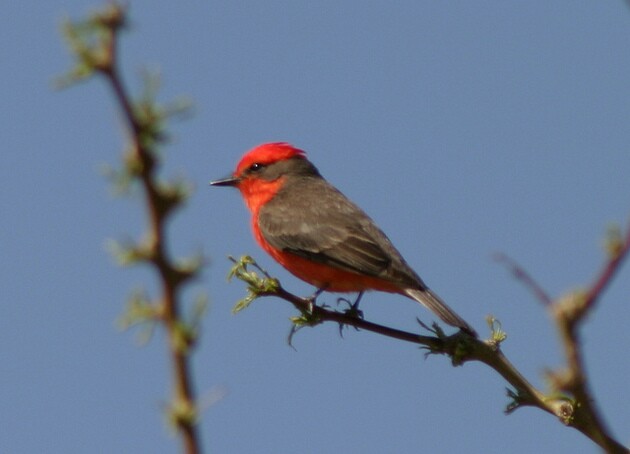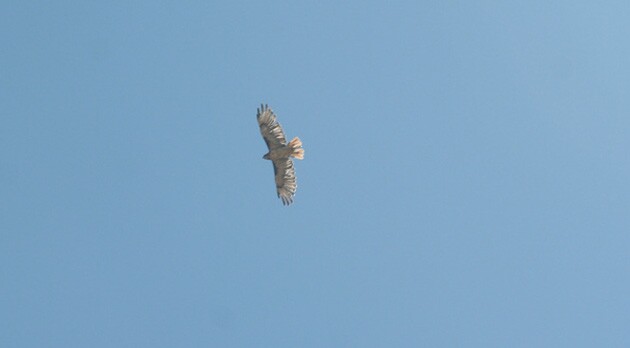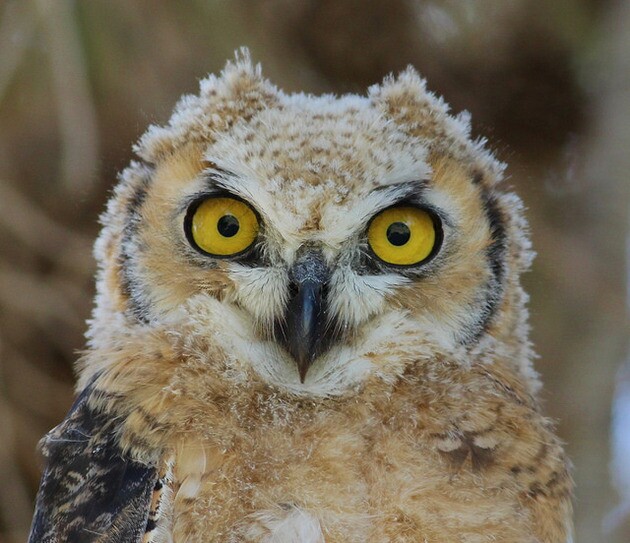Ten Great Places To Go Birding in The California Desert

Though the practice has had trouble shaking its reputation as a pastime enjoyed by a select few oddballs, as many as a fifth of Americans these days spend time observing wild birds for pleasure.
Whether you call the practice "birdwatching," as most non-birdy folks do, or "birding" as do those in the know, people who flock to bird viewing sites contributed an estimated $36 billion to the U.S. economy in 2006.
Devoted birders can take package tour birding vacations to exotic tropical locales. But why do that? There are plenty of places right here in the California Desert where you can get your bird on without hopping on a plane. Here are ten of the best.
1. Sonny Bono Salton Sea National Wildlife Refuge

The Colorado River Delta has been a crucial bit of habitat for migrating and resident birds for millions of years, and now that we've almost taken every last drop out of the river the threatened Salton Sea is one of the last vestiges of that Delta habitat.
Which means that until the Sea's level starts dropping precipitously once they shut the water off in 2018, this National Wildlife Refuge at the south end of the Sea near Brawley is a great place to see birds stopping by to rest and refuel on their migrations, as well as a bunch of locals like Yuma clapper rails and burrowing owls. In fact, birders who've record their finds at the citizen science site eBird counted 341 species at this refuge in the last few years.
Directions from Los Angeles to the Refuge's Visitor Center are here: it's about a three-hour drive. The Refuge is 227 feet below sea level and relatively humid for the desert, so if you go there during the summer be sure to take extreme desert gear: broad-brimmed hat, cotton clothing, and way more water than you can possibly imagine drinking.
2. Afton Canyon

Here's another example of the power of water in the desert to draw birds from miles around: Afton Canyon, about 42 miles east of Barstow on Interstate 15, is a spot where the Mojave River flows above ground year-round. and where there's water, there's wildlife.
Even though Afton Canyon is a bit harder to get to than some other birding hotspots, what with the three-plus miles of dirt road between the Interstate and the BLM's campground on the river, eBird users have documented 80 species in the canyon.
You can expect to see roadrunners, owls, open-desert birds like phainopeplas and verdins, flycatchers and warblers that are almost certainly on their way somewhere, and waterfowl that might just seem entirely out of place in the middle of the Mojave.
Other wildlife visiting the river — or living in it year-round — include desert bighorn sheep and an isolated population of western pond turtles, and some of the loudest trains you ever camped next to in the middle of the night.
3. Big Morongo Canyon

A stone's throw off busy Route 62 in Morongo Valley between Palm Springs and Joshua Tree National Park, Big Morongo Canyon is a marvelous spot for birders and non-birders alike. A spring choked with tules, willows and cottonwoods occupy the top of a steep-walled canyon, an old foot route between the Mojave and Colorado deserts. Just to the west, the foothills of the San Bernardino Mountains angle steeply up toward Big Bear and beyond.
Which means you've got birds that frequent both those deserts here, as well as some like scrub jays and pinyon jays that are more commonly found in more coastal places. It's a land where ecosystems collide, and it's also just a great place for hiking and picnicking. eBird users count more than 220 species here in recent visits, ranging from eagles to hummingbirds and cactus wrens to great egrets.
4. Oasis of Mara, Joshua Tree National Park

This historic palm oasis in Twentynine Palms is slightly the worse for wear these days, as water wells have removed much of the groundwater that fed the spring on which more than the canonical 29 palm trees relied.
But it's still an important stopping-over point for migrating warblers, and a great place to see more steadily resident birds as well. And since it's right in the middle of Twentynine Palms — running roughly between the Joshua Tree National Park visitor center on Utah Trail and the 29 Palms Inn — it's an easy stop to combine with other sightseeing, or even errand running.
Somewhere in the neighborhood of a hundred different species of bird have been noted at various points along the Oasis corridor by eBird users. They include the commonplace cactus wrens and mourning doves, desert regulars like cactus wrens, the obligatory non-native denizens of desert cities like pigeons and Eurasian collared doves, and birds incredibly far from where they're supposed to be, as in a 2011 sighting of a Cape May warbler.
5. Cima Dome, Mojave National Preserve

Though there's precious little surface water here in the heart of the Mojave Preserve, that doesn't mean there are no birds to look at. The broad quartz monzonite shoulders of the Dome support the world's largest forest of Joshua trees with an astoundingly diverse understory of desert shrubs beneath them. And that diversity brings birds with it.
There are a few birds here that are closely associated with Joshua trees, like the ladderback woodpeckers and flickers that drill holes in the softened wood and eat larvae of the yucca giant-skipper they find therein. Black-chinned sparrows and Bell's sparrows, found throughout much of the California desert, flit from branch to branch of the Joshuas and the shrubs below them. Some Cima Dome birds, like Scott's orioles, are seasonal visitors: here in summer, but in the forests of Costa Rica during the harsh Mojave winter.
And Cima Dome, along with the nearby Ivanpah Valley, is about the best place I know of for seeing golden eagles in the entire California desert.
Unlike the Oasis of Mara, Cima Dome is dozens of miles from anywhere, and the nearest services are expensive and unreliable. Come prepared with plenty of water, food and, if possible, camping gear.
6. Lake Tamarisk Desert Resort

This golf community with its artificial lake near Desert Center in Riverside County may be a bit of an ecological boondoggle when it comes to sensible water use, but it's a great place to see birds as they stopover in their migrations across the northern Colorado Desert. With 216 species recorded on eBird, this little golf course out in the middle of nowhere is a bird magnet — to the point where records of birds spotted here have been introduced as evidence in determining the wildlife impact of large solar installations in the neighborhood.
Birds noted at Lake Tamarisk in recent months include migrating warblers, water birds such as ducks and grebes, shorebirds from sandpipers to egrets, and year-round residents such as Gambel's quail, verdins and yellow-rumped warblers.
The resort is privately owned; check the website to find policies regarding casual visitors. Overnight guests may decide to make this part of a loop birders' tour with Big Morongo Canyon and the Oasis of Mara.
7. Palo Verde Ecological Reserve

A bit more than 1,300 acres in two parcels along the Colorado River north of Blythe, this former ranch was acquired by the Trust for Public Land in 2004. With some sections leased for alfalfa farming each year, the Reserve is managed to provide habitat for a number of bird species, most notably the southwestern willow flycatcher and the yellow-billed cuckoo.
That means replanting cottonwoods and honey mesquites in former cropland areas, and upland vegetation farther from the Reserve's four miles of riverfront. More than 1,000 acres have been restored with over a million native, bird-attracting plants have been put in by a consortium of agencies led by the U.S. Bureau of Reclamation and the present landowner, the California Department of Fish and Game.
That's been an important boon to some of the desert's most beleaguered wildlife, including the Townsend's big-eared bat and two species of cotton rat, the Colorado River and Yuma hispid.
What about birds? eBird users have recorded 177 different species at the Palo Verde Ecological Reserve, and the website of the Lower Colorado River Multi-Species Conservation Program, of which the Reserve is an important part, has a page describing the birds they study most carefully, including lovelies such as Gila woodpeckers and elf owls.
The Reserve is about 10 miles outside of Blythe with access available via an unpaved portion of Second Avenue.
8. Butterbredt Spring

Like Big Morongo Canyon, this spot is at the junction of a number of different ecological regions: the Sierra Nevada, the Mojave Desert, and the Tehachapi Mountains all meet here, with the Great Basin desert starting only little ways north. That means important diversity in birds here. Plus, the Spring's location in a relatively low pass between the desert and the Central Valley means a lot of migrants as well, especially in April and May.
An example of what it means to be at the cusp of so many different biomes: there are a few closely related California bird species that are easiest to tell apart by the fact that their ranges don't overlap much. Several of those ranges overlap here. So you're likely to find the sister species ladderbacks and Nuttall's woodpeckers both here at Butterbredt Spring, as well as California and mountain quail.
All in all, 216 species of bird have been documented here by eBird users. And that's something, considering the fact that the Spring isn't particularly accessible, meaning fewer birders will show up just on a whim. The directions Google Maps offers from Los Angeles involve a stretch of Jawbone Canyon Road that may best a low-clearance vehicle, or one with bad tires. Follow the alternate, longer directions provided here by Audubon California, or stop at the BLM ranger station at Jawbone Canyon and State Route 14 and ask for advice.
9. China Ranch Date Farm

Of all the places you can choose to bird in the California Desert, this is the one with the best date shakes. 173 bird species have been documented here by eBirders, at this little date palm plantation surrounded by willow and cottonwood riparian groves on China Ranch Creek, a tributary of the Amargosa River near Tecopa.
Owned by environmental activists who helped found the Amargosa Conservancy, China Ranch explicitly welcomes visitors who show up with birding at the top of their agenda. The Ranch also offers hiking trails with maps and interpretive displays for you to work off the calories from those date shakes. The Ranch also offers an online checklist of birds sighted on the property.
At four hours from Los Angeles, China Ranch is a little far for a day trip, but lodging can be found nearby in Tecopa and Shoshone. Or make it part of a multi-day trip through Death Valley.
10. Mono Lake

The Mother Of All Desert Birding Sites. With well over 200 species documented at eBird in a number of different spots around the lake, this hypersaline lake is a crucial stopover for migratory birds on the Pacific Flyway.
That importance to Western birds is why ornithologist David Gaines and his colleagues first campaigned to save the lake from the water-grasping ways of the Los Angeles Department of Water and Power. Though Gaines died in 1988, some years before a legal settlement permanently protected the lake from water diversions, his legacy lives on in the excellent birding still to be had at Mono. Millions of water birds show up here each year, including at least 35 species of shorebirds, and birds that make semipermanent residence in the surrounding blend of Great Basin desert and Yosemite high country are well-represented in the records.
There's pretty much no bad place to bird along Mono's 9.3 miles of shoreline, but get your bearings at the Mono Lake Visitor Center a few miles north along Route 395 from Lee Vining. Then explore. (Mono Lake County Park, at the northwestern corner of the lake, is a great place to start.)